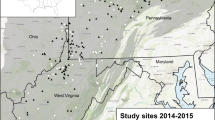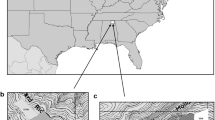Abstract
Understanding the consequences of hurricanes on the food resources available to neotropicalnearctic migrant songbirds may provide important insight into the effects of hurricanes on migratory populations. During autumn migration 2006 we investigated the foraging ecology of two species of insectivorous migrants, Blue-gray Gnatcatcher (Polioptila caerulea) and Yellow Warbler (Dendroica petechia), and the availability of their foraging substrates and arthropod food resources in two coastal forests in western Louisiana, which were impacted to different degrees by Hurricane Rita in autumn 2005. Both migrant species attacked prey on bark substrates significantly more frequently, and on live foliage less frequently, in severely damaged forest than in lightly damaged forest (χ2 tests, P < 0.05). However, both species attacked prey on bark less than expected given its availability (i.e., migrants avoided bark), and attacked prey on live foliage more than expected given its availability (i.e., migrants selected live foliage), in severely damaged forest (χ2 tests, P < 0.03). Branch-clipping revealed that arthropod biomass on live hackberry (Celtis laevigata) and sweet acacia (Acacia farnesiana) branches was significantly higher in severely damaged forest than in lightly damaged forest (Mann-Whitney test, P < 0.01). However, because live foliage was significantly less available in severely damaged forest, overall food availability for migrants was lower in severely damaged forest than in lightly damaged forest. Migrant use of, and arthropod biomass on, bark and live-foliage substrates were thus dependent on the availability of those substrates, which differed between sites as a result of hurricane-related habitat disturbance. These results demonstrate that severe hurricane disturbance reduces food availability for insectivorous songbirds during migratory stopover by reducing the availability of preferred foraging substrates.
Similar content being viewed by others
Literature Cited
Aborn, D. A. 1994. Correlation between raptor and songbird numbers at a migratory stopover site. Wilson Bulletin 106: 150–54.
Agrawal, A. A. and D. A. Spiller. 2004. Polymorphic button-wood: effects of disturbance on resistance to herbivores in green and silver morphs of a Bahamian shrub. American Journal of Botany 91: 1990–97.
Askins, R. A. and D. N. Ewert. 1991. Impact of Hurricane Hugo on bird populations on St. John, U.S. Virgin Islands. Biotropica 23: 481–87.
Barrow, W. C., Jr., C.-C. Chen, R. B. Hamilton, K. Ouchley, and T. L. Spengler. 2000a. Disruption and restoration of en route habitat, a case study: the chenier plain. Studies in Avian Biology 20: 71–87.
Barrow, W., J. Buler, B. Couvillion, R. Diehl, S. Faulkner, F. Moore, and L. Randall. 2007a. Broad-scale response of landbird migration to the immediate effects of Hurricane Katrina. p. 131–136. In G. S. Farris, G. J. Smith, M. P. Crane, C. R. Demas, L. L. Robbins, and D. L. Lavoie (eds.) Science and the Storms — the USGS Response to the Hurricanes of 2005. U.S. Geological Survey Circular 1306.
Barrow, W., P. Chadwick, B. Couvillion, T. Doyle, S. Faulkner, C. Jeske, T. Michot, L. Randall, C. Wells, and S. Wilson. 2007b. Cheniere forest as stopover habitat for migrant landbirds: immediate effects of Hurricane Rita. p. 147–56. In G. S. Farris, G. J. Smith, M. P. Crane, C. R. Demas, L. L. Robbins, and D. L. Lavoie (eds.) Science and the Storms — the USGS Response to the Hurricanes of 2005. U.S. Geological Survey Circular 1306.
Barrow, W. C., Jr., R. B. Hamilton, M. A. Powell, and K. Ouchley. 2000b. Contribution of landbird migration to the biological diversity of the northwest Gulf coastal plain. Texas Journal of Science 52: 151–72.
Browkaw, N. V. L. and L. R. Walker. 1991. Summary of the effects of Caribbean hurricanes on vegetation. Biotropica 23: 442–47.
Butler, R. W. 2000. Stormy seas for some North American songbirds: are declines related to severe storms during migration? Auk 117: 518–22.
Cimprich, D. A., M. S. Woodrey, and F. R. Moore. 2005. Passerine migrants respond to variation in predation risk during stopover. Animal Behaviour 69: 1173–79.
Coley, P. D. and J. A. Barone. 1996. Herbivory and plant defenses in tropical forests. Annual Review of Ecology and Systematics 27: 305–55.
Cooper, R. J. and R. C. Whitmore. 1990. Arthropod sampling methods in ornithology. Studies in Avian Biology 13: 29–37.
Doyle, T. W., W. H. Conner, R. H. Day, K. W. Krauss, and C. M. Swarzenski. 2007. Wind damage and salinity effects of Hurricanes Katrina and Rita on coastal baldcypress forests of Louisiana. p. 163–68. In G. S. Farris, G. J. Smith, M. P. Crane, C. R. Demas, L. L. Robbins, and D. L. Lavoie (eds.) Science and the Storms — the USGS Response to the Hurricanes of 2005. U.S. Geological Survey Circular 1306.
Faulkner, S., W. Barrow, T. Doyle, M. Baldwin, T. Michot, C. Wells, and C. Jeske. 2007. Sediment deposition from Hurricane Rita on Hackberry Beach chenier in southwestern Louisiana. p. 157–62. In G. S. Farris, G. J. Smith, M. P. Crane, C. R. Demas, L. L. Robbins, and D. L. Lavoie (eds.) Science and the Storms — the USGS Response to the Hurricanes of 2005. U.S. Geological Survey Circular 1306.
Finch, D. M. and W. Yong. 2000. Landbird migration in riparian habitats of the Middle Rio Grande: a case study. Studies in Avian Biology 20: 88–98.
Halbert, S. E. and P. M. Choate. 1999. An Asian wooly hackberry aphid, Shivaphis celti Das (Homoptera: Aphididae). Florida Department of Agriculture and Consumer Services, Entomology Circular No. 392.
Hejl, S. J., J. Verner, and G. W. Bell. 1990. Sequential versus initial observations in studies of avian foraging. Studies in Avian Biology 13: 166–73.
Johnson, M. D. 2000. Evaluation of an arthropod sampling technique for measuring food availability for forest insectivorous birds. Journal of Field Ornithology 71: 88–109.
Karban, R. and I. T. Baldwin. 1997. Induced Responses to Herbivory. University of Chicago Press, Chicago, IL, USA.
Kerlinger, P. 1989. Flight Strategies of Migrating Hawks. University of Chicago Press, Chicago, IL, USA.
Knabb, R. D., D. P. Brown, and J. R. Rhome. 2006. Tropical cyclone report: Hurricane Rita, 18–26 September 2006. National Hurricane Center, Miami, Florida. Online at http:// www.nhc.noaa.gov/pdf/TCR-ALl 82005_Rita.pdf (Accessed January 2008).
Latta, S. C. and J. M. Wunderle, Jr. 1996. Ecological relationships of two todies in Hispaniola: effects of habitat and flocking. Condor 98: 769–79.
Lynch, J. F. 1991. Effects of Hurricane Gilbert on birds in a dry tropical forest in the Yucatan Peninsula. Biotropica 23: 488–96.
McGee, B. D., B. B. Goree, R. W. Tollett, B. K. Woodward, and W. H. Kress. 2006a. Hurricane Rita surge data, southwestern Louisiana and southeastern Texas, September to November 2005. U. S. Geological Survey Data Series 220. Online at http://pubs.usgs.gov/ds/2006/220/ (Accessed January 2008).
McGee, B. D., R. W. Tollett, and R. R. Mason, Jr. 2006b. Monitoring inland storm surge and flooding from Hurricane Rita. U.S. Geological Survey Factsheet 2006-3136.
Michot, T. C., C. J. Wells, and P. C. Chadwick. 2007. Aerial rapid assessment of hurricane damages to north gulf coastal habitats. p. 87–96. In G. S. Farris, G. J. Smith, M. P. Crane, C. R. Demas, L. L. Robbins, and D. L. Lavoie (eds.) Science and the Storms — the USGS Response to the Hurricanes of 2005. U.S. Geological Survey Circular 1306.
Moore, F. R. 1999. Neotropical migrants and the Gulf of Mexico: the cheniers of Louisiana and stopover ecology. p. 51–62. In K. P. Able (ed.) Gatherings of Angels: Migrating Birds and their Ecology. Cornell University Press, Ithaca, NY, USA.
Moore, F. R., S. A. Gauthreaux, Jr., P. Kerlinger, and T. R. Simons. 1995. Habitat requirements during migration: important link in conservation. p. 121–44. In T. E. Martin and D. M. Finch (eds.) Ecology and Management of Neotropical Migratory Birds: a Synthesis and Review of Critical Issues. Oxford University Press, New York, NY, USA.
Moore, F. R. and T. R. Simons. 1992. Habitat suitability and stopover ecology of Neotropical landbird migrants. p. 345–55. In J. M. Hagan and D. W. Johnston (eds.) Ecology and Conservation of Neotropical Migrant Landbirds. Smithsonian Institution Press, Washington, DC, USA.
Pérez-Rivera, R. A. 1991. Change in diet and foraging behavior of the Antillean Euphonia in Puerto Rico after Hurricane Hugo. Journal of Field Ornithology 62: 474–78.
Remsen, J. V., Jr. and S. K. Robinson. 1990. A classification scheme for foraging behavior of birds in terrestrial habitats. Studies in Avian Biology 13: 144–60.
Rosenberg, K. V. 1990. Dead-leaf foraging specialization in tropical forest birds: measuring resource availability and use. Studies in Avian Biology 13: 360–68.
Scheirer, C. J., W. S. Roy, and N. Hare. 1976. The analysis of ranked data derived from completely randomized factorial designs. Biometrics 32: 429–34.
Sillett, T. S. 1994. Foraging ecology of epiphyte-searching insectivorous birds in Costa Rica. Condor 96: 863–77.
Sillett, T. S. and R. T. Holmes. 2002. Variation in survivorship of a migratory songbird throughout its annual cycle. Journal of Animal Ecology 71: 296–308.
Smith, R., M. Hamas, M. Dallman, and D. Ewert. 1998. Spatial variation in foraging of the Black-throated Green Warbler along the shoreline of northern Lake Huron. Condor 100: 474–84.
Sokal, R. R. and F. J. Rohlf. 1995. Biometry: the Principles and Practice of Statistics in Biological Research. 3rd ed. W. H. Freeman and Company, New York, NY, USA.
Spiller, D. A. and A. A. Agrawal. 2003. Intense disturbance enhances plant susceptibility to herbivory: natural and experimental evidence. Ecology 84: 890–97.
SPSS 2002. SPSS 11.5.0 for Windows. SPSS Inc., Chicago, IL, USA.
Stockdon, H. F., L. A. Fauver, A. H. Sallenger, Jr., and C. W. Wright. 2007. Impacts of Hurricane Rita on the beaches of western Louisiana. p. 119–24. In G. S. Farris, G. J. Smith, M. P. Crane, C. R. Demas, L. L. Robbins, and D. L. Lavoie (eds.) Science and the Storms — the USGS Response to the Hurricanes of 2005. U.S. Geological Survey Circular 1306.
Waide, R. B. 1991. Summary of the response of animal populations to hurricanes in the Caribbean. Biotropica 23: 508–12.
Wiley, J. W. and J. M. Wunderle, Jr. 1993. The effects of hurricanes on birds, with special reference to Caribbean islands. Bird Conservation International 3: 319–49.
Wolda, H. 1990. Food availability for an insectivore and how to measure it. Studies in Avian Biology 13: 38–43.
Wunderle, J. M., Jr., D. J. Lodge, and R. B. Waide. 1992. Shortterm effects of Hurricane Gilbert on terrestrial bird populations on Jamaica. Auk 109: 148–66.
Author information
Authors and Affiliations
Corresponding author
Rights and permissions
About this article
Cite this article
Dobbs, R.C., Barrow, W.C., Jeske, C.W. et al. Short-term effects of hurricane disturbance on food availability for migrant songbirds during autumn stopover. Wetlands 29, 123–134 (2009). https://doi.org/10.1672/08-78.1
Received:
Accepted:
Issue Date:
DOI: https://doi.org/10.1672/08-78.1




